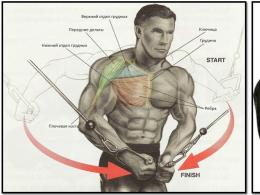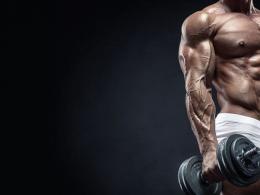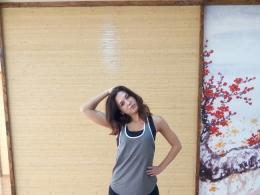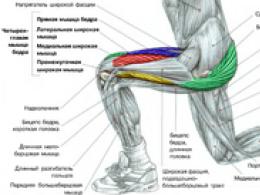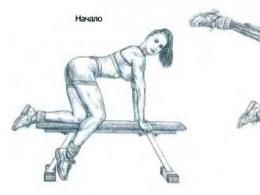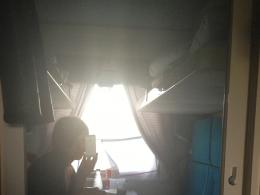Small-caliber rifle Ural 6 1. What do biathletes shoot from? The working principle of rifle parts
Sporting rifles Biathlon-7-3, Biathlon-7-3A, Biathlon-7-4, Biathlon-7-4A
Sports rifles "Biathlon" are intended for shooting in biathlon competitions at a distance of 50 m, rifles "Biathlon-7-3", "Biathlon-7-ZA" are recommended for women and juniors, "Biathlon-7-4", "Biathlon-7" -4A" - for men.
All models are created on a single design basis and differ from each other in the size of the stock and the position of the trigger relative to the handle, as well as in the version for left-handed people and with a safety lock.
The rifle barrel is locked using a crank-type mechanism with vertical axes of rotation, which allows for quick reloading without disturbing the shooter's position. The position of the center of mass of rifles is adjusted by installing or removing balancing weights.
To protect the barrel bore, front sight and diopter sight from contamination, protective covers are provided.
The trigger mechanism allows you to adjust the force, the nature of the descent and the travel of the trigger without disassembling the rifle. It is equipped with an additional trigger locking device for dry firing training.
For the Biathlon-7-ZA and Biathlon-7-4A rifles, the Anschutz barrel is used.
The design of the stock with a butt adjustable in length due to spacers, the presence of a cheekpiece adjustable in vertical and horizontal directions, allows you to choose the most convenient position when shooting.
The butt of the stock has a cassette for carrying spare magazines.
The shooting sling is quick-release and consists of two parts - a loop and a belt. The shoulder strap has an original design - with spring elements.
The rifle is equipped with two types of magazines: a regular one - for five rounds and a magazine with a cover for three additional rounds.
For firing, rimfire cartridges of 5.6 mm caliber (. 22LR) with a maximum operating pressure of powder gases of no more than 180 MPa (1836 kgf/sq. cm) are used. The parameters of the bore and chamber, as well as the locking unit, allow the use of domestic and foreign-made cartridges.
Specifications
Biathlon-7-3 | Biathlon-7-4 |
|
| Caliber, mm | 5.6 (.22LR) | 5.6 (.22LR) |
Cartridge used | ||
| Weight, kg | 4 | 4,5 |
Barrel length, mm | ||
| Trigger force adjustment limits, kgf | 0,5...1,0 | 0,5...1,0 |
Store capacity, pcs. cartridges | ||
| The amount of adjustment of the back of the butt in length, mm | 30 | 20 |
Butt cheek adjustment amount, mm | ||
| The amount of adjustment of the working stroke of the trigger, mm | 2..4 | 2..4 |
Overall dimensions, mm |
Small-caliber rifle TOZ-8. Purpose. Combat properties. Device
Purpose and combat properties of the TOZ-8 small-caliber rifle
Small-caliber weapons are subdivided into sports-mass, intended for training purposes and mass sports as a transitional to combat weapons, and sports-targeted, designed to establish the highest achievements in shooting.
The TOZ-8 small-caliber rifle is a mass-produced sports model. It is intended for initial training of sports shooters, training of discharge shooters and mass competitions in shooting ranges and shooting ranges.
Combat properties of the TOZ-8 small-caliber rifle: caliber - 5.6 mm; weight - 3.12 kg; total length - 111 cm; sighting line length is about 587 mm; initial bullet speed is about 310 m/sec; rate of fire - 10-12 rounds per minute; sighting range - 250 m; the longest bullet flight range is from 1200 to 1600 m; the destructive power of the bullet is maintained at a distance of up to 800 m.

Designation and design of rifle parts and mechanisms.
The TOZ-8 rifle consists of a barrel, receiver, trigger, sight, front sight with front sight, bolt and stock.
The barrel serves to direct the flight of the bullet.
The receiver is connected through a stump to the barrel. It serves to house the shutter and liner. A trigger mechanism is attached to it. At the rear, the receiver is closed with a lid or cap. 

IMGR2
Receiver with trigger mechanism and liner:
a - receiver; b - trigger mechanism; in - insert;
1 - channel for placing the shutter; 2 - cranked cutout; 3 - hole for the tail screw; 4 - window; 5 - hole for removal of powder gases; 6 - axis of the trigger; 7 - trigger; 8 - trigger spring; 9 - trigger spring stand; 10 - trigger spring screw; 11-reflective protrusion; 12 - guide groove for directing cartridges into the chamber; 13 - guide bevels that facilitate feeding the cartridge into the chamber; 14 - recess for the bolt cylinder rammer; 15 on the screw hole for the trigger spring screw.
The trigger mechanism is necessary to release the hammer from cocking. It consists of a trigger, a trigger spring, and a trigger spring screw. The trigger spring has a stand, the front part of which is the bolt stop, and the rear part is the sear.
The insert is designed to guide cartridges into the chamber and to deflect cartridge cases (cartridges). The bolt serves to send cartridges into the chamber, lock the bore, fire a shot, and remove the spent cartridge case. It consists of a combat cylinder, a bolt stem with a handle, a hammer, a firing pin with a striker, a mainspring and a clutch.
The combat cylinder is intended to connect all parts of the bolt. It has a channel inside for the firing pin, mainspring and coupling, and a cup for the cartridge head with a hole for the firing pin to exit. On the sides of the combat cylinder there are two longitudinal grooves: the ejector is placed in the right one, and the sleeve deflector with springs is placed in the left one. In the front lower part of the combat cylinder there is a protrusion that acts as a cartridge rammer; in the rear part there is a stump with a hole for putting on the bolt stem with a handle. 
Shutter: 1- trigger; 2-stem; 3 - mainspring; 4 - combat larva; 5 - ejector: 6 - sleeve holder; 7 - cartridge ejector spring; 8 - drummer
The bolt stem with a handle is necessary for ease of operation of the bolt. It has two large cutouts for the trigger lugs when it is released, and two small cutouts for the trigger lugs when the bolt is open. The front part of the stem is connected to the stump of the combat larva by means of a ring groove between the stump and the rear cut of the larva.
The trigger is held by the striker in cocked position. It has semicircular projections and a bevel, which is a combat cock. Inside the trigger there is a threaded hole for screwing onto the firing pin, and at the rear there is a through hole for attaching the trigger to the firing pin with a pin.
The striker is used to strike the rim of the cartridge case with the striker. A mainspring with a coupling is put on it. It has a rim in front for resting the spring and a firing pin, and in the back there is a threaded part for screwing on the trigger.
The mainspring imparts forward motion to the striker. It is put on the firing pin, with the front end resting against the rim of the firing pin, and the rear end against the coupling.
The aiming device is designed to direct the rifle at the target and give it the required aiming angle.
It consists of an open sector sight and a front sight with an earpiece.
 Small caliber side fire cartridge:
Small caliber side fire cartridge:
1- bullet; 2 - sleeve; 3 - rim of the sleeve; 4 - leading belts; 5 - powder charge; 6- shock composition; 7 - spherical recess
The cartridge for a small-caliber rifle is distinguished by the absence of a special primer. The impact composition necessary to ignite the powder charge is pressed into the head of the sleeve between the walls of its rim.
The sleeve is made of brass and has a cylindrical shape. Inside the cartridge case, in addition to the shock composition, smokeless pyroxylin powder is placed. A bullet made of an alloy of lead and antimony is strengthened in the front part of the cartridge case. In the middle part of the bullet, leading bands are made to reduce friction on the bore. On the back there is a spherical recess to prevent the breakthrough of gases between the bullet and the walls of the barrel when fired.
The working principle of rifle parts
When loading a rifle, the cartridge inserted through the receiver window, while chambering it with the bolt forward, slides along the bevels of the insert and enters the chamber. When sending the bolt forward with its cocking action, the trigger rests against the snikov spring strut and is delayed, and the stem and combat cylinder, continuing to move forward, compress the mainspring. The ejector and cartridge holder fit into the chamber cutouts, the ejector tooth jumps over the rim of the cartridge case. When the bolt stem handle is lowered along the crank cutout to the bottom position, the bolt tightly locks the barrel bore.
When you press the trigger, it turns on its axis and recesses the trigger spring, which then comes out from under the cocking mechanism.
The firing pin, under the action of the mainspring, is fed forward through the channel of the combat cylinder; the firing pin, passing through the hole in the cup of the combat cylinder, strikes the rim of the cartridge case. A shot occurs.
When unloading the rifle, when the bolt handle is turned upward, the cutouts of the stem slide along the corresponding protrusions of the trigger and press out the trigger, and with it the firing pin.
When the bolt is pulled back, the ejector removes the cartridge case from the chamber; Having encountered the reflective protrusion of the liner, the cartridge case is thrown out through the receiver window. Then the cocking of the hammer, passing over the trigger spring stand, recesses it. After cocking, the spring rises and keeps the bolt from falling out.
Purpose, combat properties and design features of the TOZ-12 small-caliber rifle
The TOZ-12 small-caliber rifle is an improved sporting model of the TOZ-8 rifle. This rifle is intended for initial training of sports shooters, training of discharge shooters and mass competitions in shooting galleries and shooting ranges.
Rifle caliber - 5.6 mm; weight - 3.5 kg; barrel length - 600-640 mm; sighting line length - 755-800 mm; number of grooves - 4; trigger pull - 0.8-0.5 kg.
The purpose and design of the barrel, receiver, trigger and bolt are the same as that of the TOZ-8 rifle. Pistol-shaped stock with an elongated fore-end.
Sights consist of a diopter sight and a front sight (the diopters and front sights are replaceable). The diopter sight consists of a square, a block with an adapter bar and a diopter.
The square has horizontal and vertical micrometric adjustment screws with heads. Divisions are applied on the heads. Each division is equal to 1/13 of a turn. When you turn the head one division, a click occurs and the middle point of impact moves 1 cm. In order to move the square vertically, you must first loosen the locking screw one turn. After making the correction, the square is again fixed with a locking screw.
The rifle comes with interchangeable rectangular and ring front sights, which are attached to the body.
The standard small-caliber rifle SM-2 is one of the most popular sporting rifles.

The rifle is produced in several versions; weighing 5 kg; weighing up to 3.6 kg (cadet), with a safety lock, with a left-handed stock, as well as in a combination of these designs.
All versions are created on a single design basis and are intended for sports shooting in prone, standing, kneeling exercises in competitions at a distance of 50 m and are recommended for women and juniors.
For ease of loading in the receiver has a special tray. The shutter is equipped with a firing pin cocking indicator.
The trigger mechanism allows you to adjust the trigger pull and trigger travel without separating the rifle from the stock.
Adjustment of the length of the buttstock and the nape of the buttstock vertically, in combination with the stock configuration, allows you to choose a comfortable position when shooting.
5.6 mm (.22LR) rimfire cartridges are used for firing. The parameters of the barrel bore, the chamber and the locking unit make it possible to successfully use both domestic and foreign cartridges.
The set of rifles includes: a set of front sights, a set of diopters, accessories for cleaning and lubrication, a shooting sling.
Specifications
| Caliber, mm | 5.6 (.22LR) |
| Barrel length, mm to perform "cadet" | 680 500 |
| 0,5...2,0 2...4 |
|
| 20 | |
vertically for version with adjustable stock comb | 10,5 |
up and down | 30 |
| Weight (without belt), kg to perform "cadet" | |
| Overall dimensions, mm to perform "cadet" | 1118x225x80 |
Modifications:
Sporting large-caliber rifles Record-1, Record-1-308, Record-2, Record-2-308
Designed for sports shooting at a distance of 300m in prone, standing, kneeling exercises.

The arbitrary rifles "Record-2" and "Record-2-308" differ from the standard rifles "Record-1" and "Record-1-308" in the design of the stock, the presence of additional adjustments to ensure the most convenience when shooting after adjusting the parameters of the rifle to individual characteristics of the athlete, and equipment.


For shooting from rifles "Record-1" and "Record-2" 7.62 mm rifle cartridge "Extra" (7.62x54R) is used, and for shooting from rifles "Record-1-308" and "Record-2-308 "- cartridge. 308 Win (7.62x51).
Specifications
| Caliber, mm | |||
| Barrel length, mm | |||
| Trigger force, adjustable, kgf | |||
| Amount of butt length adjustment, mm | |||
| Butt comb adjustment amount, mm - vertically - horizontally | |||
| The amount of adjustment of the back of the butt from the neutral position, mm - vertically - horizontally | |||
| Rifle weight (without belt), kg | |||
| Overall dimensions, mm |
Equipment
| Set of flies | |||
| Set of filters | |||
| Antimirage device (radome) | |||
| Set of adjustment tools, assembly and disassembly | |||
| Set of replacement shims for adjustment ridge and butt of the butt | |||
| Balancing weights | |||
| Additional nape hook | |||
| Level | |||
| Shooting belt | |||
| Case |
Sports large caliber standard rifles Record-CISM, Record-308-CISM
Sports large-caliber standard rifles "Record-CISM", "Record-308-CISM" are designed for sports shooting at a distance of 300 m in men's exercises lying down, standing, kneeling under the program of the International Shooting Union CISM.

Rifles are available in several versions, differing from each other in the configuration:
with diopter sight;
with safety catch, mechanical sight and bipod;
with safety lock, mechanical and optical sights and bipod;
with fuse, optical sight and bipod.
Each rifle design can be manufactured in three versions:
N - with normal accuracy of fire;
P - with increased accuracy of fire;
B - with high accuracy of fire.
set of flies*;
interchangeable front sight bodies and a transitional base for changing the height of the aiming line *;
a set of replaceable shims for adjusting the comb and butt of the butt;
two additional stores;
magazine insert for single shooting;
a set of tools for adjustment, assembly and disassembly;
a set of accessories for cleaning and lubrication;
shooting belt;
Rifle set:
antimirage device;
adjustable diopter with built-in filters *;
set of non-adjustable diopters *;
* - for rifles with a diopter sight.

Specifications
| Caliber, mm | |
| Cartridge used | "Extra" (7.62x54R) or |
| Accuracy of fire at a distance of 300 m, mm, no more, for options — N - P - IN | 105 |
| Barrel length, mm | |
| Trigger force, adjustable, kgf | |
| Trigger stroke length, adjustable, mm for version with fuse | 0,2...2,0 |
| Amount of butt length adjustment, mm | |
| Butt comb adjustment amount, mm - vertically - horizontally | |
| The amount of adjustment of the back of the butt, from the neutral position, mm - up and down - right and left | |
| Magazine capacity, cartridges | |
| Overall dimensions, mm | |
| Weight of the rifle (without optical sight, bipod and accessories), kg, no more |
Sporting small-bore rifles Ural-5-1, Ural-6-2

Designed for sport shooting at a distance of 50 m in prone, standing, and kneeling exercises. The free rifle "Ural-5-1" differs from the standard rifle "Ural-6-2" in the design of the stock, the presence of additional adjustments to ensure the greatest convenience when shooting after adjusting the parameters of the rifle to the individual characteristics of the athlete, and the configuration. Each rifle design can be manufactured in three versions:
— N - with normal accuracy;
— P - with increased accuracy;
— B - with high accuracy.
The rifles are created on a single structural base with the barrel bore being locked by turning a longitudinally sliding bolt, which has three symmetrically located lugs. The trigger mechanism without disassembling the rifle allows you to adjust the trigger force, the nature of the descent, the preliminary and working stroke of the trigger, as well as the position of the trigger relative to the handle of the stock.
For firing, 5.6 mm (.22LR) rimfire cartridges are used. The parameters of the bore, chamber and locking unit are selected so that the rifles operate equally reliably on both domestic and foreign cartridges.
Specifications
| Caliber, mm | ||
| Accuracy of fire, mm, no more for performances — N - P - IN | 13 | 13,5 |
| Barrel length, mm | ||
| Trigger force, adjustable, kgf | ||
| Trigger stroke length, adjustable, mm | ||
| Amount of butt length adjustment, mm | ||
| The amount of adjustment of the back of the butt from the neutral position, mm - up and down - right and left | ||
| Butt comb adjustment amount, mm - vertically - horizontally | ||
| Rifle weight, kg | ||
| Overall dimensions, mm |
Note*. For version with adjustable stock comb.
Rifle set
| Set of flies | ||
| Set of filters | ||
| Set of tools for adjustment, assembly and disassembly | ||
| Set of accessories for cleaning and lubrication | ||
| Set of replacement shims for adjusting the comb and butt of the stock | ||
| Stand for standing shooting (champignon) | ||
| Balancing weights | ||
| Additional nape hook | ||
| Level | ||
| Shooting belt | ||
| Case |
Modifications:
In 2015, one of the questions asked by representatives of the Russian automotive press to the general director of AZ URAL, Viktor Kadylkin, was about the prospects for the development of the new model and the production of on-road trucks based on it. It was clear that the Ural Next road family would organically complement the line of all-terrain vehicles already being produced, would better meet the requirements of carriers who do not need all-wheel drive, and would allow increasing production volumes of new vehicles. As an example, the director, who, by the way, began his career at AZ URAL as an apprentice toolmaker, was reminded of the gasoline Ural-377 6x4. It was produced from 1965 to 1983, but only connoisseurs of the history of the Miass brand now remember this car. Mostly heard of the later road trucks “Ural-63645” and “Ural-63685”, the production of which was launched in the mid-2000s. But in Russia, making promises and making forecasts is a thankless task, so then Viktor Sergeevich dispensed with a specific start date for the production of “road cars”, the expected pace and development period. Time has passed. In the fall of 2017, at the COMTRANS exhibition, they showed the first two Ural Next trucks with a 6x4 wheel arrangement - a dump truck and a truck tractor. This is the basis of the entire new line - the most popular designs. Most of the subsequent models will be created taking into account the experience and technology of their production. And although the next test drives of the Ural Next 6x4 are scheduled for the summer, we contacted the plant in advance and found out how the further development of the promising family is going.
Third time in road class
Upon a quick inspection of these cars, it seems that there are few changes, the main one being the use of a front axle beam without any gearboxes or axle shafts. In the 60s, it was in this way, using a front axle with axles from the MAZ-500, but with “Ural” hubs, that the Ural-377 6x4 was created. It retained the transfer case from the Ural-375, only without the front axle cardan, and used single-pitch tires. But then, clearly out of poverty, they tried to make the vehicle with a carrying capacity of 7.5 tons as unified as possible with the 5-ton Ural-375 SUV. In those days, the USSR produced few vehicles with a carrying capacity of more than 5 tons; there were simply no truly “heavy” trucks, and the Kama Automobile Plant was just about to be built. It is interesting that in 1977, when the Ural-4320 6x6 appeared, when the 7-liter V8 ZIL-375 gasoline engine was replaced with a Kamaz diesel engine, they did not make a similar road car based on it. Apparently, on a national scale, the expectation was that the Kama Automobile Plant and MAZ would be able to meet the needs of motor transport workers in trucks for interregional transport.
In the mid-2000s, when cabover road workers with a licensed Iveco TurboStar cab were created in Miass, they began to use a more progressive design method, using purchased units. But if URALAZ had not had this licensed cab at that moment, probably no one would have even thought of building road trucks. The Ivekov cabin has an external width of about 2300 mm, the wings of the front wheels are wider than the doors by about 100 mm on each side, that is, this is a typical truck cabin for interregional transportation or construction purposes. Since Yaroslavl V-shaped engines and gearboxes were available, the designers of the Ural AZ only had to develop a new frame and purchase drive axles with hub planetary gearboxes for an axle load of 11-13 tons. Rear axles (they do not require a transfer case) began to be purchased from the Chinese FAW - licensed Steyr. This was one of the first cases of purchasing units or components from China for the Russian automobile industry. The front axle was borrowed from KAMAZ‑6520. Actually, the new “Ural” 6x4 with a carrying capacity of up to 20 tons was supposed to compete with heavy KAMAZ and MAZ trucks. Priority in this range began to produce three-axle road "Urals". Then, based on the three-axle vehicle, they made a four-axle 8x4 version - many fewer of these vehicles were produced. And they practically manufactured truck tractors and flatbed trucks with a 4x2 wheel arrangement. The crisis of 2008-2009 forced the production of non-wheel drive Urals to be curtailed. And when in 2010 the Russian market for heavy trucks began to revive and carriers again began to show interest in purchasing road-going Urals, it turned out that it was difficult for the car plant to resume their production. However, many developments based on them have been successfully adapted to all-terrain versions of cabovers - dump trucks and truck tractors. They are still being produced: “Ural-583166” or the more famous “Ural-6370” 6x6 with a lifting capacity of 19.5 tons, with RABA axles. It was clear that the new road line would definitely be revived sooner or later, but there were disputes among the plant’s engineers about what it would be like... Some suggested focusing on a cabover scheme, regretting that it was difficult to bring the “Ivekov” cabin up to the level of comfort and quality of interior finishing level of European trucks. Others insisted on creating bonneted vehicles, especially since in the early 2010s, the development of a “Next” cab common to all GAZ Group trucks was underway in great secrecy. But, probably, in Russia we need trucks of both configurations.
It turns out that, apart from the UralZiSovs of the war era, with the road versions of the Ural Next 6x4, the car plant is establishing the production of such trucks of the third generation. Moreover, the current road range is based on the most modern components and assemblies, both Russian-made and imported.
The idea of this model was incubated for a long time, I couldn’t decide on the size, or something else. As a result, the project took 7 months.
And so I found a suitable drawing, asked a friend to scale it, took it to the printing house, where they printed out all three types on whatman paper for me. The drawing was posted on the wall for convenience.
I bought plastic (foamed PVC) 3mm thick. Well, a couple of tsacrine glues, thicker and thinner.
HobbyKing Super Cyanoacrylate Adhesive (50g / 1.7oz) Viscous.
Product http://www.site/product/7174/
HobbyKing Super Glue CA (50g / 1.7oz)
Product http://www.site/product/7173/
And away we go. Since this is the first model built with my own hands, it was decided to start slowly, the base of the cabin, the radiator grille. 

 Then I decided to start the hood, because if the hood does not fold, then the hands are hooks and there is no point in continuing. But after a week of crafts and alterations, something similar came out.
Then I decided to start the hood, because if the hood does not fold, then the hands are hooks and there is no point in continuing. But after a week of crafts and alterations, something similar came out. 



The hood honestly took out the brain. More sooner.
The hood was put on hinges  Hatch Hinge 27x10.5mm (10pcs)
Hatch Hinge 27x10.5mm (10pcs)
Product http://www.site/product/8230/
Doors  Ultralight pin hinges L2.5xW10xD43mm (10pcs)
Ultralight pin hinges L2.5xW10xD43mm (10pcs)
Product http://www.site/product/9629/ But then I collected a lot of different loops. 



Then I started thinking about the frame because... There were suspicions with the steering of the wheels; under the wings the cabin seemed too wide. I made it into a rough frame. And I was right, I had to narrow the lower part under the wings. 
Then a two-speed transmission from Traxxas summit arrived, I knew that it was very reliable, not by hearsay, since I had this model. Stuck it on the frame. 
Meanwhile, I was slowly making a little salon and mirrors. 

Gearbox handles, transfer cases, lowering gears. 
Rubber bands for handles, by the way, these are seals for rods from ship models.
Next, I began to work closely on the frame and front and rear suspension.
The springs were made from a construction spatula, cut, bent, and drilled where necessary.
I chose the bridges not for the sake of copyability, but they are very reliable, since the model was not meant to be a shelf model, but for trophy rides in the mud, mountains and other difficult landscapes.
Axial SCX10 bridges, studs are all made from cleaned 2mm and 3mm welding electrodes, then we cut the threads and bend them where necessary.
I ordered the cardans from JunFac from the CC01 chassis; according to my calculations, their dimensions suited me.
Power, on the advice of knowledgeable people, was ordered a Holmes Hobbies collector regulator called brxl, and a blue motor with 45 turns, high-torque and moderately high-speed.
Handout from Misha Holodilnik, from the well-known forum. 






The steering wheel will be controlled by a very good servo. They work for me and are very successful.  Analog servo HK15328A Analog BB/MG 58g / 12.8kg / 0.20sec
Analog servo HK15328A Analog BB/MG 58g / 12.8kg / 0.20sec
Product http://www.site/product/442024/ It's at the checkpoint  HXT900 (9g micro servo)
HXT900 (9g micro servo)
Product http://www.site/product/662/ The spacers between the spring and the bridge serve to level the ground clearance, and without them the steering rod would touch the spring.
Then everything was put in order, disassembled again and everything was painted separately. There was a test drive of the frame, after which the paint peeled off the frame, we had to disassemble everything again and repaint it. The final paint was matte black for alloy wheels, it turned out to be ok 

In the meantime, footrests were made from a sheet of metal tiles 0.6 mm thick. Cut it out, tried it on, then punched it with a core, not quickly. :) 

Then the question began to rest on the wheels, but after an unsuccessful fitting of 1.9-size wheels, it was decided not to save money and buy normal tires. In general, the wheels are size 2.2, with an outer diameter of 120mm.
I had to think a lot about the optics. The head light fits well out of two sets.
 Turnigy High Power Headlight System
Turnigy High Power Headlight System
Product http://www.site/product/1486354/ And glass and lattice
 LED headlights for trophy cars (made of stainless steel).
LED headlights for trophy cars (made of stainless steel).
Product http://www.site/product/989644/ The double-sided turn signal was made from Chinese caps from pressure meters on cars 1:1.
This cap has a separator installed and everything is painted silver, close to chrome, so that the diodes do not expose each other.
And the dimensions on the roof and repeaters were cut out of caps from orange fountain pens.
The rear optics were made from bicycle reflectors.
Next, the rear winch was installed as on the original. I made the winch from an old half-dead XP DS1015 servo machine, after some manipulations it worked as it should. As a result, the winch pulls the Urals even with locked wheels, in general, it’s even more stupid than we would like.
And the moment of preparation for painting was approaching. Well, it turned out to be the simplest thing, I took it to the body shop where a painter I knew worked and explained that I needed Multikam camouflage.
Yes, the photos of working with the kung were lost somewhere, but there’s nothing special there, a square is just a square. 
While the Ural was being painted, I got confused with the wiring. It took a week and 20 meters of wires and probably a dozen resistors.
And this block of light came up well
The three-axle off-road truck (6x6 wheel arrangement) of the “Next” family, designed with an onboard cargo platform, which replaced the “old man 4320” (in fact, being the result of its deep modernization), officially appeared before the public in early June 2015 - at an international specialized exhibition "Construction Equipment and Technologies", held in Moscow. In addition to the “innovative appearance”, this car received a thoroughly “shaken up” technology and a lot of modern functionality.
Like its two-axle “brother”, the onboard Ural-Next 6×6 is equipped with a cabin from the new generation of GAZelles, which makes it look bright and attractive even against the background of foreign “classmates”.
The vehicle is available in several versions: with an onboard cargo platform (optional with a cargo handling unit) - for transporting various types of cargo; or in the “chassis” version – designed for mounting various types of superstructures. And the “6x6” wheel arrangement allows this truck to be used on any road, as well as in off-road conditions.

The overall dimensions along the outer perimeter of the Ural 4320 Next are as follows: 9000 mm in length, 2259 mm in width and 2952 mm in height. When installing an onboard platform, the length of the vehicle increases by 600 mm and the width by 197 mm. Its wheelbase is 4755+1400 mm, and the minimum ground clearance is 400 mm.

The “all-terrain vehicle from Miass” is capable of fording hard-bottomed fords up to 700 mm deep, and special training allows this figure to be increased to 1200 mm.
In “combat” condition, the Ural-4320 Next weighs 8,245 kg, and its total weight is 22,500 kg. At maximum load, the front axle carries 5,300 kg (with a reinforced axle – 6,500 kg), and the rear axle – 16,000 kg.
The three-axle truck flaunts a two-door cab with a metal frame and the “tail” (fenders, hood, lining of the running boards, engine compartment and radiator grille) made of heavy-duty polymer.

The interior, inherited from the same GAZelle Next, is distinguished by its modern design and well-thought-out ergonomic features. To comfortably accommodate the driver, this Ural is equipped with a Grammer driver's seat with air suspension, and passengers are offered a simple two-seater sofa.
Specifications. The Ural-4320 Next is driven by a YaMZ-536 in-line diesel six with a volume of 6.65 liters with direct Common-Rail fuel supply and a Borg Warner turbocharger, generating 312 “horses” at 2300 rpm and 1226 Nm of torque at 1300 rpm. 1600 rpm.
Weaker options are also available with output of 240, 270 and 285 horsepower and from 900 Nm of torque at 1300-1600 rpm.

The engine is paired with a ZF manual gearbox with nine gears and a dry single-plate clutch (optional, you can install a 5-speed manual transmission YaMZ-1105).
Like its “two-axle brother,” the “6x6” truck has in its arsenal a permanent all-wheel drive with center and cross-axle differential locks, as well as a transfer case with a reduction gear (gear ratio is 2.15).
In technical terms, the “Ural Next 6×6” almost completely replicates the “four-wheeler”: a modernized Ural-M platform with a reinforced frame, spring-balanced suspension on all axles with semi-elliptical springs, a pneumatic braking system with drum-type devices and an optional ABS system, as well as an integral type steering system with hydraulic control booster.
Prices. In 2017, the Ural Next 6×6 chassis vehicle is asking for ~2,550,000 rubles, but a flatbed truck will cost 2.7 ~ 5.0 million rubles (depending on the version and equipment). The list of standard and optional equipment is similar to that of the 4x4 model.

